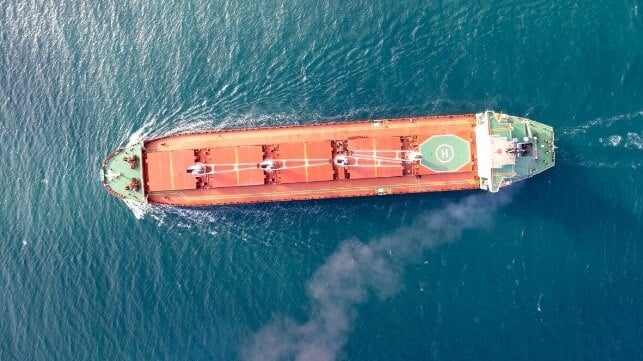Carbon Capture is No Silver Bullet, But Holds Opportunities for Shipping

 Can onboard carbon capture and storage (CCS) technology be a viable tool in shipping’s decarbonization journey? Answering this question requires a holistic perspective, accounting for the entire carbon value chain. In short, the technical ability to capture and store CO2 is only part of the equation – what happens to the captured carbon is equally important.
Can onboard carbon capture and storage (CCS) technology be a viable tool in shipping’s decarbonization journey? Answering this question requires a holistic perspective, accounting for the entire carbon value chain. In short, the technical ability to capture and store CO2 is only part of the equation – what happens to the captured carbon is equally important.
Recent studies have revealed promising results on the technical feasibility of capturing CO2 on board ships, showing achievable capture rates between 82% and 90%. For example, a joint research project by Bureau Veritas and Wah Kwong has confirmed the technical viability of integrating a carbon capture, liquefaction and storage system on two in-service bulk carriers.
Bureau Veritas’ latest technology report examines the available evidence on the technical viability of current carbon capture and storage technology for the maritime market. It concludes that while CCS can be a promising option to reduce shipping’s greenhouse gas emissions, it is no silver bullet and must be used in conjunction with other decarbonization strategies to achieve the maritime industry’s goals.
Furthermore, the report points out that for onboard carbon capture to make sense, it needs to be assessed in the context of the overall value chain. In practice, we need to consider the handling and disposal of the captured CO2, the infrastructure needed to handle and process it in ports, the availability and location of storage sites, and potential markets for carbon.
The potential of CCS for shipping
While alternative fuels will be instrumental in bringing shipping to net-zero, there are still questions surrounding their availability in time to meet the first IMO checkpoint of reducing the total annual GHG emissions from international shipping by at least 20%, striving for 30%, by 2030.
Shipping needs new solutions, in addition to energy-saving devices and voyage optimization, in order to achieve its decarbonization targets, particularly in the short to medium term. Therefore, the role of carbon capture technology in reducing CO2 emissions from existing engines cannot be overlooked.
The experience gained in the use of carbon capture technologies in onshore installations can be leveraged for their commercialization and application to maritime transport. However, the cost and applicability of carbon capture on board vessels will vary greatly depending on the type of technology used, but also on the ship’s type, size and the fuel used.
Regulatory, technical and operational challenges
Carbon capture is not without its challenges. One of the most significant uncertainties is how CCS technologies will be addressed by the IMO and other regional regulatory frameworks. From an operational perspective, concerns have been raised regarding potential corrosion, the safe handling of CO2, as well as the available space to accommodate the equipment and storage tanks onboard.
Furthermore, carbon capture is an energy-intensive process, requiring a significant amount of heat to regenerate the solvent (in other words, reverse the CO2 absorption reaction). This, among other factors, can lead to a considerable increase in fuel consumption related to system operation, depending on the desired capture rate.
A 2022 study by the Maersk Mc-Kinney Moller Center for Zero Carbon Shipping illustrates this challenge. While the maximum achievable capture rate was considered to be 82%, the study pointed out that actual CO2 savings were lower when considering the rise in fuel consumption – up to 45% – caused by the CO2 system itself.
Another study by Stena Bulk and the Oil & Gas Climate Initiative on a Suezmax tanker running on heavy fuel oil achieved 90% capture rates. However, the vessel’s fuel consumption was increased by 53% when operating at that rate. In comparison, fuel consumption only increased by 22% with a CO2 capture rate of 50%, and no additional fuel was consumed with a CO2 capture rate of 8%.
A supply chain perspective
When assessing the feasibility of carbon capture technology onboard vessels, it is vital to do so within the context of the entire CCUS value chain, taking into account the potential challenges and opportunities related to the management of the captured CO2.
BV’s recent CCS report also highlights the significant role that shipping can play in facilitating the development of a global carbon capture, utilization, and storage (CCUS) value chain as a major mode of CO2 transportation, particularly given the growing interest in offshore storage sites.
Globally, some 230 million metric tons of CO2 are already used in industrial applications every year. This includes the production of fertilizers, steel, and food and beverages. Moreover, captured CO2 can be used to produce molecules for synthetic fuels such as e-methane and e-methanol, which provide a low-carbon alternative to fossil fuels, including for the shipping industry.
Shipping’s role in CCUS value chains
Shipping already plays an important role in the CCUS value chain as one of the main modes of transport for CO2. Liquid CO2 carriers are used to transport relatively small quantities of food-grade liquid CO2 for the food and beverage industry, with capacities ranging from 1,200 m3 to 1,800 m3 at maximum working pressures of 18 bar gauge and a maximum service temperature of -40°C.
Whereas pipeline systems are used to transport large quantities of CO2 over relatively short distances, they are generally associated with a high initial investment cost and lack of flexibility. On the other hand, shipping transportation offers flexibility in terms of CO2 sources, routes, and shorter set-up times. They, therefore, appear to be an alternative solution to pipelines in the case of scattered emitters over long distances and for relatively smaller transport quantities.
Finally, it is also worth noting that several countries and regions are promoting the development of carbon capture, utilization and storage (CCUS) by introducing financial support and regulatory frameworks to back CCUS R&D and project development. With the right regulations and infrastructure in place, shipping could benefit from the development of a truly circular CO2 economy, whilst contributing to the industry’s own ambitious decarbonization targets.
Marcos Salido, Environmental Project Manager (Strategy & Advanced Services) at Bureau Veritas Marine & Offshore, is the lead author of the report “Onboard Carbon Capture: An Overview of Technologies to Capture CO2 Onboard Ships."
The opinions expressed herein are the author's and not necessarily those of The Maritime Executive.
